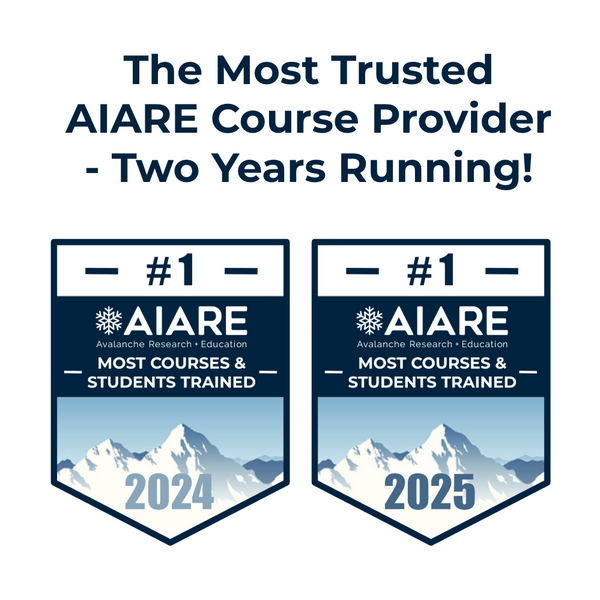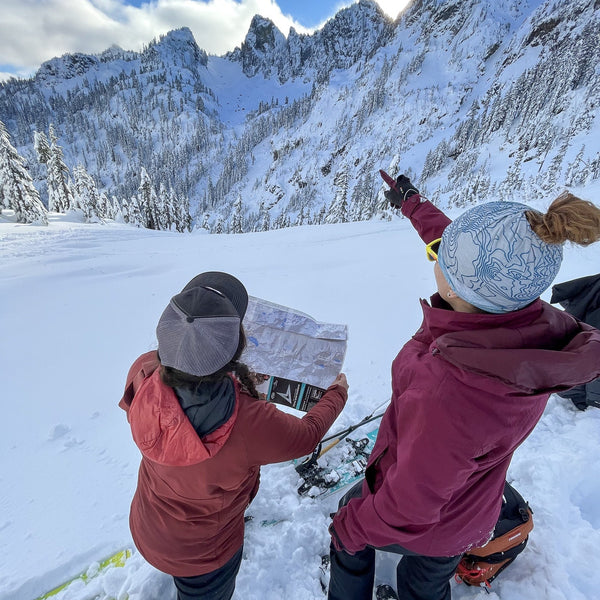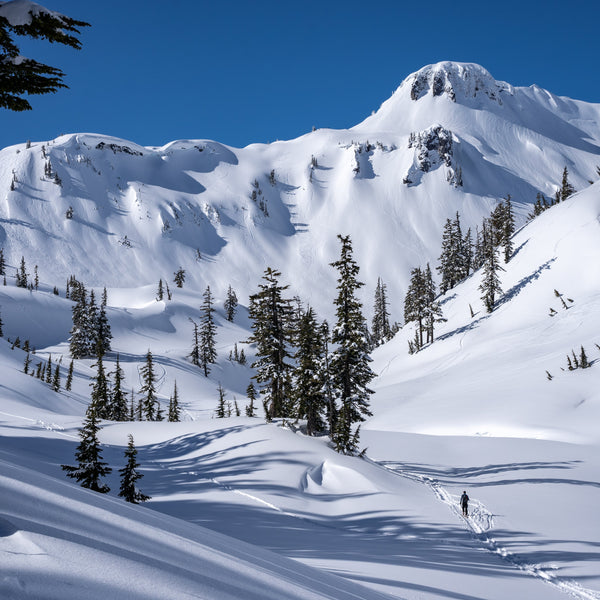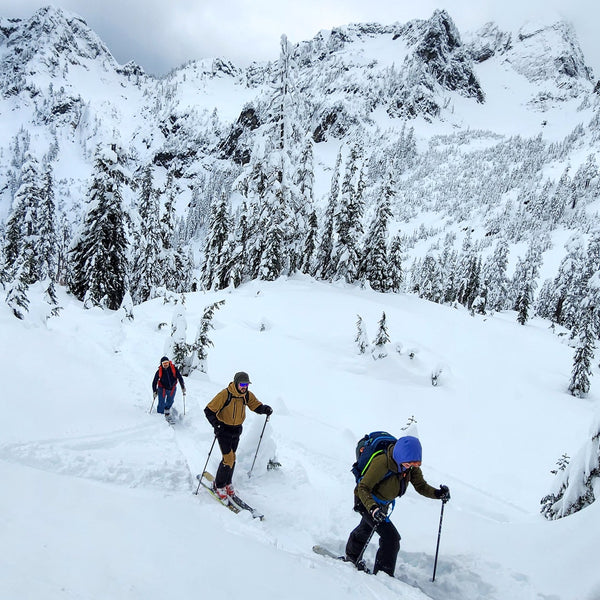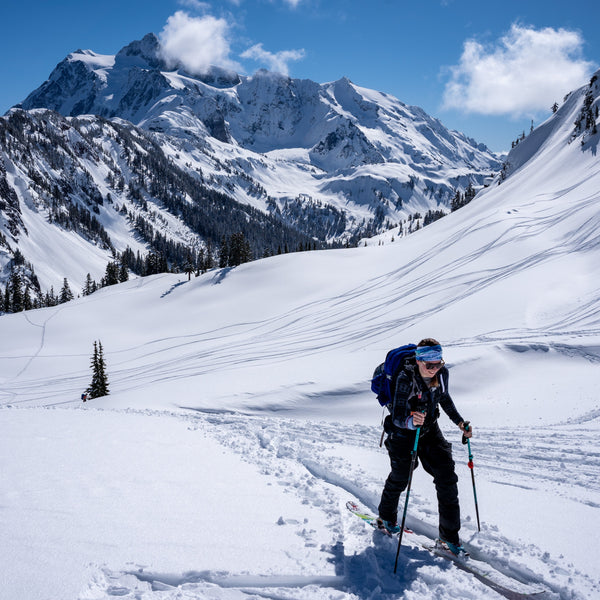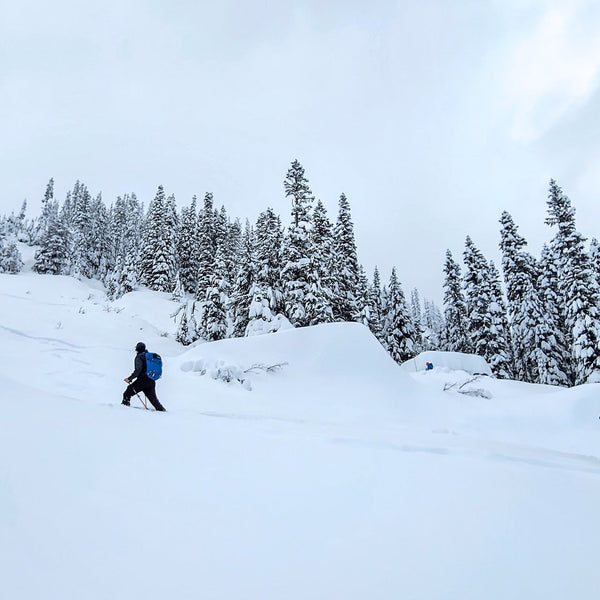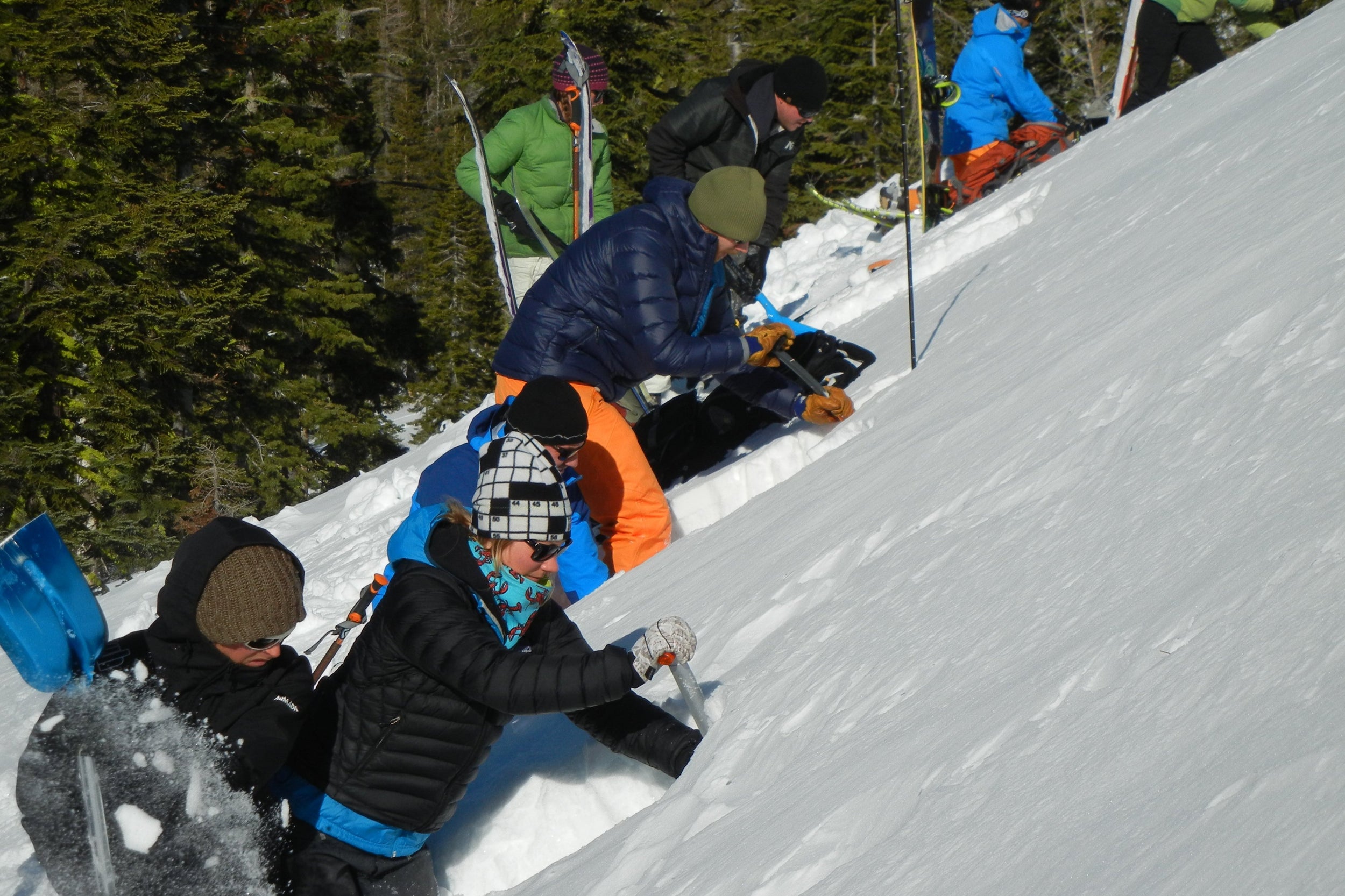
AIARE 1 + Rescue Avalanche Course - Washington
Gain essential backcountry safety skills with our AIARE 1 + Rescue Avalanche Course in Washington (Mt Baker or Snoqualmie Pass). This 3-day course follows the curriculum set by the American Institute for Avalanche Research and Education (AIARE) and is designed for skiers and splitboarders who want to travel safely in avalanche terrain. Taught by AIARE-Certified instructors, the course also includes a full Avalanche Rescue training component—so you walk away with both AIARE Level 1 and AIARE Rescue certifications.
Please let us know if you would like to be in the same group as other participants in the notes section when booking! We cannot accommodate last minute group switches.
During your AIARE 1 + Rescue course, we'll cover the following topics and skills:
AIARE 1 Course Curriculum
- Mountain Snowpack
- Mountain Weather
- The Avalanche Problems
- Trip Planning
- Snow and Weather Observations
- Terrain Choice
- Human Factors and Assembling your Team
- Trailhead Departure Check
- Route Finding
- Track Setting
- Descent Choices
- What to do if you're caught in an avalanche
- What to do if your partner is caught in an avalanche
- How to use your beacon, shovel and probe
- Rescue equipment technology
- Rescue techniques for companion and small team rescue
- How terrain affects an avalanche rescue and how to use terrain to your advantage
- Visual search, transceiver search and spot probing
- Strategies for using your gear effectively
Frequently Asked Questions
What's the difference between AIARE 1 and AIARE 1 + Rescue Avalanche Courses?
-
AIARE 1 is a 24 hour program, typically with 8 of those hours devoted to classroom study. Of the remaining 16 hours, eight is typically devoted to planning and executing a ski tour and 4 hours are for a snow pit, observations, terrain, decision making, etc (full list below), and 4 hours are for avalanche rescue practice.
Our AIARE 1 + Rescue adds a day of field work, which not only provides more comprehensive rescue training, but it allows us to cover the rest of critical the AIARE 1 topics in much more depth than a normal AIARE 1 course since none of the 16 hours devoted to AIARE 1 time are used for rescue practice (there is a full day for this built in!).
You'll walk away with vastly superior avalanche rescue skills and more firsthand knowledge of terrain, snowpack and observations. For more benefits of the AIARE 1 + Rescue course check our blog post: What's the difference between AIARE 1 and AIARE 1 + Rescue?
What are the differences between taking an AIARE 1 + Rescue at Mt Baker and Snoqualmie Pass?
-
Snoqualmie Pass is an excellent AIARE 1 + Rescue course location due to its accessibility, lower-elevation terrain, and variable snowpack. The area features tree-filled glades and steep slopes, giving students experience with tighter, more confined terrain like tree wells and terrain traps. Snoqualmie also has highly variable snow conditions, including frequent rain-on-snow events, which create crust layers that affect snow stability. Its weather can change rapidly, with mixed precipitation and rain being common at lower elevations, providing an opportunity to learn how to handle rain-affected snow conditions. Just an hour from Seattle, Snoqualmie is ideal for students looking for a more convenient, controlled learning environment while still dealing with complex backcountry conditions.
Mt. Baker offers a more remote and challenging backcountry environment, known for its expansive alpine terrain, steep ridgelines, and large avalanche paths. With some of the heaviest snowfall in North America, Mt. Baker has a deep, complex snowpack that allows students to experience a range of snow conditions, including wind slabs and persistent weak layers. The weather at Baker can be extreme, with frequent storms and high winds creating rapidly changing conditions, perfect for teaching advanced risk assessment in an exposed alpine setting. Located further from urban areas, Mt. Baker provides a more immersive backcountry experience, ideal for those seeking advanced training in rugged, high-consequence terrain.
Why choose Blackbird Mountain Guides for your AIARE 1 + Rescue course?:
-
Whether it's for our expert, AIARE-certified instructors, flexible online learning options, or practical rescue training, there are many reason why students choose us. Our courses focus on real-world skills in varied terrain, making learning more efficient and applicable. Additionally, the combination of high-quality instruction and innovative course formats helps our students retain knowledge and stay prepared for real avalanche scenarios. This makes us a trusted choice for anyone serious about avalanche safety education.
For more info check out our blog post about what makes Blackbird's AIARE courses different.
This program requires at least 3 participants to run.
Here's the schedule for your course:
- 6 Hour Online Course - can be completed any time prior to the pre-field webinar
- 2 Hour Pre-Field Zoom Webinar on either:
7pm PT Wednesday (For Weekend Courses)
7pm PT Monday (For Midweek Courses) - Field Day 1 - AIARE Rescue - 8:00am meetup with your guide at the trailhead, 3:00-3:30pm end time.
- Field Day 2 - AIARE 1 - 8:00am meetup with your guide at the trailhead, 3:30-4:00pm end time. Course venue will be determined after Field Day 1, based on weather and snow conditions
- Field Day 3 - AIARE 1 - 8:00am meetup with your guide at the trailhead, 3:30-4:00pm end time. Course venue will be determined after Field Day 2, based on weather and snow conditions
Here are the skills and fitness you'll need for your course:
- Advanced Resort Riding skills - Including off-piste terrain in challenging snow conditions
- Basic Backcountry Touring Skills - Including familiarity with equipment and avalanche gear
- Basic Fitness - Able to spend an active day outside, moving uphill at 1,000’ per hour for durations of roughly 1 hour between breaks. Participants should be able to hike 3-5 miles and climb 1,000-1,500 vertical feet throughout the course of the day.
- Ski/Split Touring & Avalanche Gear - Come prepared with your own gear or rent from us
Here's what's included with your course:
- Experienced AMGA/AIARE Trained Guide
- Mt Baker-Snoqualmie National Forest Permit
- Interactive Online Course with lifetime access
- AIARE Field Book (a $30 value)
- AIARE Certification/Student Fees (a $35 value)
- Group Safety Gear - Snow Science, First Aid Kits
- Wag Bags - for human waste disposal, in compliance 'Leave No Trace' principles
- Ski/Splitboard Gear
- Avalanche Gear
- Transportation
- Meals
- Winter Parking Passes
- Guide Gratuities
Ski Touring and Avalanche Program Gear List
- Avalanche Gear - Come prepared with your own gear or rent from Blackbird
- Ski/Split Touring Gear - Come prepared with your own gear or rent from:
Know Before you go
or
Mt Baker, WA

PRIVATE PROGRAMS
- Custom Scheduling: Choose your dates and plan around your availability.
- Tailored Experiences: Itineraries and objectives are adjusted to suit your goals, experience, and fitness.
- Cost-Effective for Most Large Groups: Private programs are typically more cost-effective for groups of 3 or more.
- Flexibility Comes at a Price: For groups of 1-2, private programs are generally more expensive.
- AIARE Courses: AIARE course pricing is based on a group of 6. Running these as a private program with fewer than 6 participants will increase the per-person cost.
SCHEDULED PROGRAMS
- Fixed Dates & Costs: Scheduled programs have set dates, itineraries, objectives, and pricing.
- Great for Solo or Small Groups: Ideal for individuals or small groups looking to share costs with others.
- Affordable for 1-2 People: Scheduled programs are typically less expensive for groups of 1-2.
- Less Flexibility: Dates fill quickly, and group programs require adapting to the skill level and pace of all participants
- Group Atmosphere: Meet others with similar interests and make some new backcountry buddies!
Note: Any scheduled program can also be run as a private program with customized dates and rates.
Both options offer exceptional guiding and experiences. Choose what works best for you!
Day 1: Avalanche Rescue
8:00 am Meet your guide at The Trailhead. Open with introductions, gear-up and tour into the rescue zone. We’ll begin with covering gear and fundamental skills before moving into an instructor rescue demo and participant-led scenarios.
3:00-3:30 pm We'll wind down the program to tour to the trailhead and debrief the major learning lessons of the day.
7:00-9:00 pm Webinar to cover AIARE 1 Avalanche Course content. We may choose to do this section in person depending on where participants are staying for the evening, weather and other factors that will be worked out with the team.
Day 2: AIARE 1: Observations & Snowpack Tests
8:00 am Meet your guide and review the plan for the day. The day will center around observations, assessment of weather and snowpack, and evaluating and moving through or near avalanche terrain.
3:30pm We will close the day with a margin of daylight remaining when we hit the trailhead. Safely back at the cars, we’ll review the day and debrief the decisions we made. Debriefs are very helpful for building useful experience quickly!
Day 3: AIARE 1: Backcountry Tour
8:00 am Meet your guide at the trailhead, ready with weather and avalanche hazard forecasts. We’ll review the plan for the day, including a discussion of the day’s avalanche problem, the proposed route up and options for the ascent and descent. The guide will facilitate a Trailhead Departure Check/Beacon Check.
8:30 am We’ll begin the tour, making decisions based on our trip plan, weather forecast and the avalanche advisory for the day. Along the way, we’ll make snowpack and weather observations and open discussions on where we should go and how we should travel. Your guide will provide insights and foster sound decision making as the group navigates the challenges of the terrain, snowpack and weather.
3:30 pm We will once again close the program with a margin of daylight remaining when we hit the trailhead and we’ll debrief the day. Once we’ve covered the decisions and outcomes of the day, we’ll close the course with thoughts on the best ways to move forward with your backcountry progression!
Gain essential backcountry safety skills with our AIARE 1 + Rescue Avalanche Course in Washington (Mt Baker or Snoqualmie Pass). This 3-day course follows the curriculum set by the American Institute for Avalanche Research and Education (AIARE) and is designed for skiers and splitboarders who want to travel safely in avalanche terrain. Taught by AIARE-Certified instructors, the course also includes a full Avalanche Rescue training component—so you walk away with both AIARE Level 1 and AIARE Rescue certifications.
Please let us know if you would like to be in the same group as other participants in the notes section when booking! We cannot accommodate last minute group switches.
During your AIARE 1 + Rescue course, we'll cover the following topics and skills:
AIARE 1 Course Curriculum
- Mountain Snowpack
- Mountain Weather
- The Avalanche Problems
- Trip Planning
- Snow and Weather Observations
- Terrain Choice
- Human Factors and Assembling your Team
- Trailhead Departure Check
- Route Finding
- Track Setting
- Descent Choices
- What to do if you're caught in an avalanche
- What to do if your partner is caught in an avalanche
- How to use your beacon, shovel and probe
- Rescue equipment technology
- Rescue techniques for companion and small team rescue
- How terrain affects an avalanche rescue and how to use terrain to your advantage
- Visual search, transceiver search and spot probing
- Strategies for using your gear effectively
Frequently Asked Questions
What's the difference between AIARE 1 and AIARE 1 + Rescue Avalanche Courses?
-
AIARE 1 is a 24 hour program, typically with 8 of those hours devoted to classroom study. Of the remaining 16 hours, eight is typically devoted to planning and executing a ski tour and 4 hours are for a snow pit, observations, terrain, decision making, etc (full list below), and 4 hours are for avalanche rescue practice.
Our AIARE 1 + Rescue adds a day of field work, which not only provides more comprehensive rescue training, but it allows us to cover the rest of critical the AIARE 1 topics in much more depth than a normal AIARE 1 course since none of the 16 hours devoted to AIARE 1 time are used for rescue practice (there is a full day for this built in!).
You'll walk away with vastly superior avalanche rescue skills and more firsthand knowledge of terrain, snowpack and observations. For more benefits of the AIARE 1 + Rescue course check our blog post: What's the difference between AIARE 1 and AIARE 1 + Rescue?
What are the differences between taking an AIARE 1 + Rescue at Mt Baker and Snoqualmie Pass?
-
Snoqualmie Pass is an excellent AIARE 1 + Rescue course location due to its accessibility, lower-elevation terrain, and variable snowpack. The area features tree-filled glades and steep slopes, giving students experience with tighter, more confined terrain like tree wells and terrain traps. Snoqualmie also has highly variable snow conditions, including frequent rain-on-snow events, which create crust layers that affect snow stability. Its weather can change rapidly, with mixed precipitation and rain being common at lower elevations, providing an opportunity to learn how to handle rain-affected snow conditions. Just an hour from Seattle, Snoqualmie is ideal for students looking for a more convenient, controlled learning environment while still dealing with complex backcountry conditions.
Mt. Baker offers a more remote and challenging backcountry environment, known for its expansive alpine terrain, steep ridgelines, and large avalanche paths. With some of the heaviest snowfall in North America, Mt. Baker has a deep, complex snowpack that allows students to experience a range of snow conditions, including wind slabs and persistent weak layers. The weather at Baker can be extreme, with frequent storms and high winds creating rapidly changing conditions, perfect for teaching advanced risk assessment in an exposed alpine setting. Located further from urban areas, Mt. Baker provides a more immersive backcountry experience, ideal for those seeking advanced training in rugged, high-consequence terrain.
Why choose Blackbird Mountain Guides for your AIARE 1 + Rescue course?:
-
Whether it's for our expert, AIARE-certified instructors, flexible online learning options, or practical rescue training, there are many reason why students choose us. Our courses focus on real-world skills in varied terrain, making learning more efficient and applicable. Additionally, the combination of high-quality instruction and innovative course formats helps our students retain knowledge and stay prepared for real avalanche scenarios. This makes us a trusted choice for anyone serious about avalanche safety education.
For more info check out our blog post about what makes Blackbird's AIARE courses different.
This program requires at least 3 participants to run.
Here's the schedule for your course:
- 6 Hour Online Course - can be completed any time prior to the pre-field webinar
- 2 Hour Pre-Field Zoom Webinar on either:
7pm PT Wednesday (For Weekend Courses)
7pm PT Monday (For Midweek Courses) - Field Day 1 - AIARE Rescue - 8:00am meetup with your guide at the trailhead, 3:00-3:30pm end time.
- Field Day 2 - AIARE 1 - 8:00am meetup with your guide at the trailhead, 3:30-4:00pm end time. Course venue will be determined after Field Day 1, based on weather and snow conditions
- Field Day 3 - AIARE 1 - 8:00am meetup with your guide at the trailhead, 3:30-4:00pm end time. Course venue will be determined after Field Day 2, based on weather and snow conditions
Here are the skills and fitness you'll need for your course:
- Advanced Resort Riding skills - Including off-piste terrain in challenging snow conditions
- Basic Backcountry Touring Skills - Including familiarity with equipment and avalanche gear
- Basic Fitness - Able to spend an active day outside, moving uphill at 1,000’ per hour for durations of roughly 1 hour between breaks. Participants should be able to hike 3-5 miles and climb 1,000-1,500 vertical feet throughout the course of the day.
- Ski/Split Touring & Avalanche Gear - Come prepared with your own gear or rent from us
Here's what's included with your course:
- Experienced AMGA/AIARE Trained Guide
- Mt Baker-Snoqualmie National Forest Permit
- Interactive Online Course with lifetime access
- AIARE Field Book (a $30 value)
- AIARE Certification/Student Fees (a $35 value)
- Group Safety Gear - Snow Science, First Aid Kits
- Wag Bags - for human waste disposal, in compliance 'Leave No Trace' principles
- Ski/Splitboard Gear
- Avalanche Gear
- Transportation
- Meals
- Winter Parking Passes
- Guide Gratuities
Ski Touring and Avalanche Program Gear List
- Avalanche Gear - Come prepared with your own gear or rent from Blackbird
- Ski/Split Touring Gear - Come prepared with your own gear or rent from:
the blackbird difference
We’re here to help. Our FAQs or Gear Lists might have the information you’re seeking. But If you’re not finding the information you need, we’d be happy to help!
